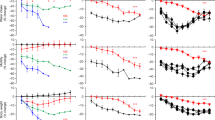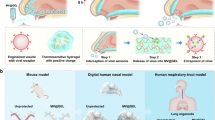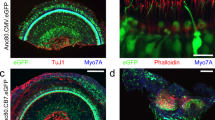Abstract
Intranasal instillation is used to deliver adenoviral vectors to the olfactory epithelium and respiratory tract. The success of this approach, however, has been tempered by inconsistent infectivity in both the epithelium and lungs. Infection of the epithelium may be hampered in part by the convoluted structure of the cavity, the presence of mucus or poor airflow in the posterior cavity. Delivery of adenovirus to the lungs can be uneven in the various lobes and distal bronchioles may be poorly infected. Current approaches to circumvent these issues rely principally on intubation or intratracheal instillation. Here we describe a technique that significantly improves adenoviral infectivity rates without requiring surgical intervention. We use compressed air to increase circulation of instilled adenovirus, resulting in enhanced infection in both the epithelium and lungs. This procedure is straightforward, simple to perform and requires no specialized equipment. In the epithelium, neurons and sustentacular cells are both labeled. In the lungs, all lobes can be infected, with penetration to the most distal bronchioles. The use of compressed air will likely also be useful for enhancing the distribution of other, desired agents within the epithelium, central nervous system and respiratory tract.
This is a preview of subscription content, access via your institution
Access options
Subscribe to this journal
Receive 12 print issues and online access
$259.00 per year
only $21.58 per issue
Buy this article
- Purchase on Springer Link
- Instant access to full article PDF
Prices may be subject to local taxes which are calculated during checkout





Similar content being viewed by others
References
Chesler AT, Zou DJ, Le Pichon CE, Peterlin ZA, Matthews GA, Pei X et al. A G protein/cAMP signal cascade is required for axonal convergence into olfactory glomeruli. Proc Natl Acad Sci USA 2007; 104: 1039–1044.
Crystal RG, McElvaney NG, Rosenfeld MA, Chu CS, Mastrangeli A, Hay JG et al. Administration of an adenovirus containing the human CFTR cDNA to the respiratory tract of individuals with cystic fibrosis. Nat Genet 1994; 8: 42–51.
Damjanovic D, Zhang X, Mu J, Medina MF, Xing Z . Organ distribution of transgene expression following intranasal mucosal delivery of recombinant replication-defective adenovirus gene transfer vector. Genet Vaccines Ther 2008; 6: 5.
Danielyan L, Schafer R, von Ameln-Mayerhofer A, Buadze M, Geisler J, Klopfer T et al. Intranasal delivery of cells to the brain. Eur J Cell Biol 2009; 88: 315–324.
Dhuria SV, Hanson LR, Frey II WH . Intranasal drug targeting of hypocretin-1 (orexin-A) to the central nervous system. J Pharm Sci 2009; 98: 2501–2515.
Holtmaat AJ, Hermens WT, Sonnemans MA, Giger RJ, Van Leeuwen FW, Kaplitt MG et al. Adenoviral vector-mediated expression of B-50/GAP-43 induces alterations in the membrane organization of olfactory axon terminals in vivo. J Neurosci 1997; 17: 6575–6586.
Zhao H, Ivic L, Otaki JM, Hashimoto M, Mikoshiba K, Firestein S . Functional expression of a mammalian odorant receptor. Science 1998; 279: 237–242.
Dhuria SV, Hanson LR, Frey II WH . Intranasal delivery to the central nervous system: mechanisms and experimental considerations. J Pharm Sci 2010; 99: 1654–1673.
Bridle BW, Boudreau JE, Lichty BD, Brunelliere J, Stephenson K, Koshy S et al. Vesicular stomatitis virus as a novel cancer vaccine vector to prime antitumor immunity amenable to rapid boosting with adenovirus. Mol Ther 2009; 17: 1814–1821.
Mathison S, Nagilla R, Kompella UB . Nasal route for direct delivery of solutes to the central nervous system: fact or fiction? J Drug Target 1998; 5: 415–441.
Zhao H, Otaki JM, Firestein S . Adenovirus-mediated gene transfer in olfactory neurons in vivo. J Neurobiol 1996; 30: 521–530.
Ganguly S, Moolchandani V, Roche JA, Shapiro PS, Somaraju S, Eddington ND et al. Phospholipid-induced in vivo particle migration to enhance pulmonary deposition. J Aerosol Med Pulm Drug Deliv 2008; 21: 343–350.
Holtmaat AJ, Hermens WT, Oestreicher AB, Gispen WH, Kaplitt MG, Verhaagen J . Efficient adenoviral vector-directed expression of a foreign gene to neurons and sustentacular cells in the mouse olfactory neuroepithelium. Brain Res Mol Brain Res 1996; 41: 148–156.
DuPage M, Dooley AL, Jacks T . Conditional mouse lung cancer models using adenoviral or lentiviral delivery of Cre recombinase. Nat Protoc 2009; 4: 1064–1072.
Driscoll KE, Costa DL, Hatch G, Henderson R, Oberdorster G, Salem H et al. Intratracheal instillation as an exposure technique for the evaluation of respiratory tract toxicity: uses and limitations. Toxicol Sci 2000; 55: 24–35.
Sinn PL, Burnight ER, Hickey MA, Blissard GW, McCray Jr PB . Persistent gene expression in mouse nasal epithelia following feline immunodeficiency virus-based vector gene transfer. J Virol 2005; 79: 12818–12827.
Rodriguez S, Sickles HM, Deleonardis C, Alcaraz A, Gridley T, Lin DM . Notch2 is required for maintaining sustentacular cell function in the adult mouse main olfactory epithelium. Dev Biol 2008; 314: 40–58.
Suzuki Y, Takeda M . Keratins in the developing olfactory epithelia. Brain Res Dev Brain Res 1991; 59: 171–178.
Margolis FL . Olfactory marker protein (OMP). Scand J Immunol Suppl 1982; 9: 181–199.
Southam DS, Dolovich M, O'Byrne PM, Inman MD . Distribution of intranasal instillations in mice: effects of volume, time, body position, and anesthesia. Am J Physiol Lung Cell Mol Physiol 2002; 282: L833–L839.
Soriano P . Generalized lacZ expression with the ROSA26 Cre reporter strain. Nat Genet 1999; 21: 70–71.
Fasbender A, Lee JH, Walters RW, Moninger TO, Zabner J, Welsh MJ . Incorporation of adenovirus in calcium phosphate precipitates enhances gene transfer to airway epithelia in vitro and in vivo. J Clin Invest 1998; 102: 184–193.
Teijeiro-Osorio D, Remunan-Lopez C, Alonso MJ . New generation of hybrid poly/oligosaccharide nanoparticles as carriers for the nasal delivery of macromolecules. Biomacromolecules 2009; 10: 243–249.
Xenariou S, Griesenbach U, Liang HD, Zhu J, Farley R, Somerton L et al. Use of ultrasound to enhance nonviral lung gene transfer in vivo. Gene Therapy 2007; 14: 768–774.
Brand K, Klocke R, Possling A, Paul D, Strauss M . Induction of apoptosis and G2/M arrest by infection with replication-deficient adenovirus at high multiplicity of infection. Gene Therapy 1999; 6: 1054–1063.
Acknowledgements
We thank Stephanie Yaszinski for assistance with perfusion and dissection of the lungs, and the Weiss lab for the Ad-cre virus. We thank the Roberson lab for use of the luminometer. DML was supported by NIH DC007489, AG033241 and the Alzheimer's Association.
Author information
Authors and Affiliations
Corresponding author
Ethics declarations
Competing interests
The authors declare no conflict of interest.
Rights and permissions
About this article
Cite this article
Gau, P., Rodriguez, S., De Leonardis, C. et al. Air-assisted intranasal instillation enhances adenoviral delivery to the olfactory epithelium and respiratory tract. Gene Ther 18, 432–436 (2011). https://doi.org/10.1038/gt.2010.153
Received:
Revised:
Accepted:
Published:
Issue Date:
DOI: https://doi.org/10.1038/gt.2010.153
Keywords
This article is cited by
-
Transduction of ferret airway epithelia using a pre-treatment and lentiviral gene vector
BMC Pulmonary Medicine (2014)
-
Aβ alters the connectivity of olfactory neurons in the absence of amyloid plaques in vivo
Nature Communications (2012)



